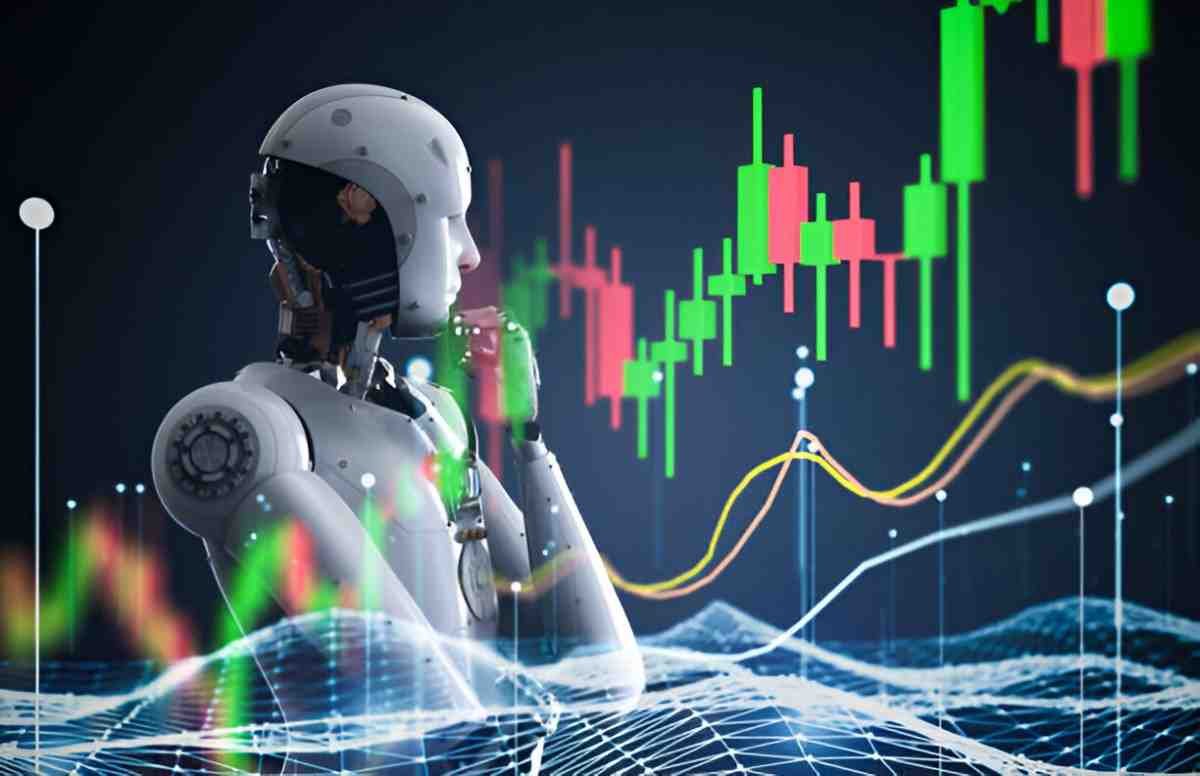When I first heard about AI stock trading, I was curious about how artificial intelligence could potentially change the landscape of investing. Stock trading has always been a game of strategy, timing, and, sometimes, pure luck. However, with AI stepping into the arena, I started to wonder whether the future of investing could be reshaped by algorithms and machine learning. In this article, I will dive into AI stock trading, exploring its fundamentals, potential benefits, challenges, and real-world examples. By the end, you’ll have a solid understanding of how AI is making its mark in the stock market and what it could mean for your investment journey.
Table of Contents
What is AI Stock Trading?
AI stock trading, also known as algorithmic trading or robo-trading, uses artificial intelligence (AI) and machine learning (ML) algorithms to automate trading strategies in the stock market. Unlike traditional stock trading, where human traders analyze market data and make decisions based on experience and intuition, AI trading systems process massive amounts of data and execute trades based on pre-set rules or patterns they have learned over time.
I think the most intriguing aspect of AI stock trading is its ability to learn and adapt. AI systems are designed to continually improve their strategies by analyzing past market data and adjusting their actions accordingly. This process is called “training,” where the AI system refines its predictive capabilities and decision-making processes over time.
Key Components of AI Stock Trading
When I look at AI stock trading, I focus on three key components that make it work:
- Data Collection: AI needs a large dataset to analyze and learn from. This data includes historical stock prices, trading volumes, market news, and other relevant factors that could influence stock prices. The more data the AI system has access to, the better it can identify patterns and trends.
- Machine Learning Algorithms: Once the data is collected, machine learning algorithms are used to identify patterns, trends, and correlations within the data. These algorithms can be supervised, unsupervised, or reinforcement learning-based, depending on the type of AI system being used.
- Execution: After analyzing the data and making predictions, the AI system executes trades automatically. The trades are typically based on pre-determined strategies or real-time market conditions. AI systems can respond much faster than human traders, executing orders within milliseconds.
How Does AI Stock Trading Work?
To better understand how AI stock trading works, let me break it down into simple steps.
- Data Gathering: The AI system starts by collecting vast amounts of data from different sources. This can include historical stock prices, financial reports, news articles, social media sentiment, and even weather patterns that could impact certain industries. The more varied the data, the better the AI system can understand the market dynamics.
- Pattern Recognition: After collecting the data, the AI system looks for patterns. It might identify trends in stock prices, correlations between market events, or even seasonal changes in certain industries. These patterns can help the AI system make predictions about future market movements.
- Training and Testing: Once the system identifies patterns, it needs to test its predictions. The AI system undergoes a process known as “training,” where it uses historical data to refine its predictions. The system is tested repeatedly on new data to ensure its accuracy. It keeps learning and adapting, improving its decision-making abilities over time.
- Execution of Trades: Once the AI system has learned how to predict stock price movements, it can start executing trades based on predefined strategies. These strategies could include buying stocks when certain conditions are met or selling when the price hits a certain threshold. The AI system can execute these trades much faster than a human trader.
- Continuous Learning: Even after executing trades, the AI system continues to learn. It monitors the results of its trades, adjusts its strategies based on the outcomes, and refines its approach to better predict future market movements.
Types of AI Trading Systems
There are various types of AI trading systems that differ in terms of how they use data, the algorithms they rely on, and the trading strategies they employ. Here are some of the most common ones:
1. Rule-Based Systems
In a rule-based AI trading system, the AI follows a set of predefined rules to make trading decisions. These rules are usually based on technical indicators like moving averages, price momentum, and volume analysis. Rule-based systems are simple but effective, especially when markets are stable and predictable. However, they may struggle to adapt to sudden market changes.
2. Machine Learning-Based Systems
Machine learning-based systems use advanced algorithms to analyze data and learn from it. These systems can adapt to new market conditions and adjust their strategies based on historical data and real-time market events. Machine learning systems tend to be more flexible than rule-based systems, but they require a large amount of data to perform effectively.
3. Deep Learning-Based Systems
Deep learning is a subset of machine learning that uses neural networks to model complex relationships within large datasets. These systems are capable of processing vast amounts of data and identifying patterns that might be too complex for traditional machine learning models. Deep learning-based systems are highly accurate but require a significant amount of computational power and data to function effectively.
4. Reinforcement Learning Systems
Reinforcement learning is a type of machine learning where the AI learns by interacting with the environment. It receives feedback in the form of rewards or penalties based on the actions it takes. In stock trading, the AI learns to make better decisions over time by analyzing the outcomes of its trades. This approach is particularly useful for developing trading strategies in dynamic and uncertain markets.
Benefits of AI Stock Trading
As I delve deeper into AI stock trading, I find that the potential benefits are numerous. Here are a few that stand out to me:
1. Speed and Efficiency
One of the primary advantages of AI stock trading is the speed at which trades can be executed. AI systems can process vast amounts of data and execute trades within milliseconds, much faster than a human trader could ever manage. This speed can lead to better market opportunities and reduced slippage.
2. Data-Driven Decision Making
Unlike human traders, who are influenced by emotions and biases, AI systems make decisions based solely on data. This eliminates the risk of emotional trading and ensures that decisions are made in a logical, objective manner. By focusing on data, AI trading systems can spot trends and opportunities that might be missed by human traders.
3. Automation and 24/7 Trading
AI stock trading systems operate around the clock, meaning they can analyze the market and execute trades at any time. This continuous operation can help investors take advantage of market movements outside of regular trading hours. Additionally, the automation of trading reduces the need for constant monitoring, freeing up time for other tasks.
4. Backtesting and Strategy Optimization
AI systems can backtest strategies using historical data to determine how well a trading strategy would have performed in the past. This allows traders to test their strategies without risking real money. Over time, the system optimizes strategies based on real-time performance, further improving its ability to make profitable trades.
5. Risk Management
AI trading systems can also be programmed to manage risk effectively. They can set stop-loss orders, monitor portfolio diversification, and ensure that the risk levels of individual trades align with the investor’s goals. AI can minimize losses by reacting swiftly to market downturns or other unfavorable conditions.
Challenges of AI Stock Trading
While AI stock trading has numerous advantages, it also comes with its challenges. Understanding these challenges is crucial to making informed decisions about whether or not to use AI for stock trading.
1. Lack of Transparency
One of the biggest challenges with AI stock trading is the lack of transparency. Since AI systems can be highly complex, it can be difficult to understand how they make decisions. This lack of transparency can be concerning for investors who want to understand the reasoning behind each trade.
2. Overfitting
Overfitting occurs when an AI system becomes too reliant on historical data and fails to adapt to new market conditions. While the AI may perform well on past data, it might struggle in real-time trading when market conditions change. To avoid overfitting, the AI system must be constantly monitored and updated.
3. Data Quality
AI trading systems depend on the quality of the data they are fed. If the data is inaccurate or incomplete, the AI system may make poor decisions. Ensuring that data is reliable, timely, and relevant is crucial for the success of AI trading.
4. High Costs
Implementing AI stock trading systems can be expensive, especially for individual investors. The costs associated with acquiring high-quality data, building AI models, and maintaining the system can add up quickly. While institutional investors might have the resources to afford these costs, it can be a barrier for smaller investors.
5. Ethical Concerns
AI stock trading raises ethical concerns, particularly around the issue of market manipulation. AI systems can execute trades at speeds that humans cannot match, potentially influencing the market in ways that are not always transparent or fair. Regulators are still figuring out how to address these issues, and the risk of market manipulation is a real concern for many investors.
Example of AI Stock Trading in Action
To help illustrate how AI stock trading works, let’s consider a simple example. Imagine an AI trading system designed to trade based on historical price patterns.
Example: Simple Moving Average (SMA) Strategy
Let’s assume that an AI system is programmed to follow a simple moving average (SMA) strategy. The system looks at the stock’s price over the last 50 days and compares it with the stock’s price over the last 200 days. If the 50-day moving average crosses above the 200-day moving average, the system buys the stock. If the 50-day moving average crosses below the 200-day moving average, the system sells the stock.
Step 1: Data Collection: The AI system collects data on the stock’s price over the last 50 and 200 days.
Step 2: Pattern Recognition: The AI system recognizes when the 50-day SMA crosses above or below the 200-day SMA.
Step 3: Execution: If the system detects a crossover, it executes a buy or sell order automatically.
Example Calculation:
- 50-day SMA = (Sum of last 50 days’ prices) / 50
- 200-day SMA = (Sum of last 200 days’ prices) / 200
If the 50-day SMA is $120 and the 200-day SMA is $110, the system would buy the stock, anticipating a price increase. If the 50-day SMA falls to $105 while the 200-day SMA remains at $110, the system would sell the stock.
This is a basic example, but it shows how AI systems can use algorithms to make decisions based on data, without the need for human intervention.
Conclusion
As I reflect on the potential of AI stock trading, I see a promising future for investors who embrace this technology. AI has the ability to process large amounts of data, make objective decisions, and execute trades faster than human traders. However, it’s essential to understand the challenges, such as lack of transparency, overfitting, and data quality issues. While AI trading systems are still evolving, I believe they have the potential to reshape the way we approach investing in the stock market. Whether you’re an experienced trader or a beginner, understanding AI stock trading can give you a competitive edge in today’s fast-paced financial world.





